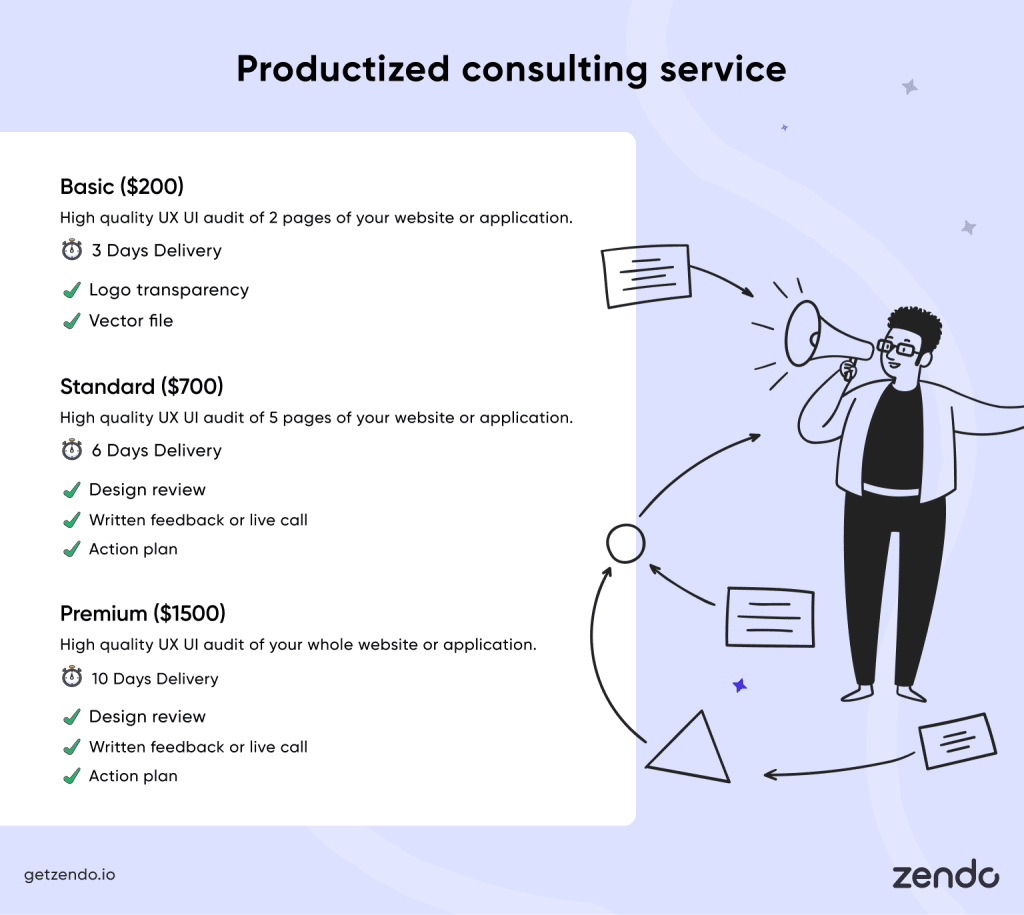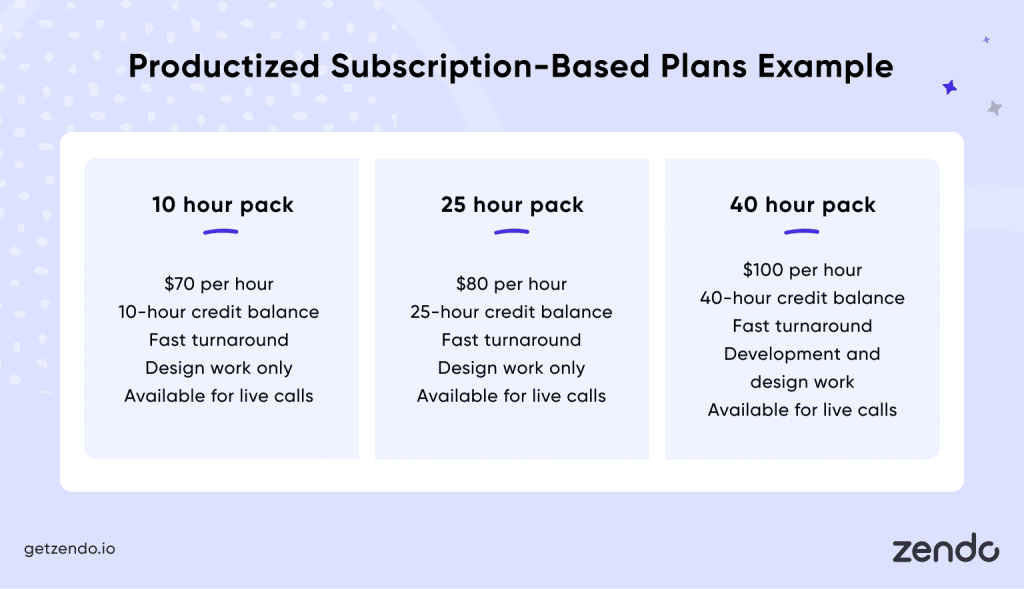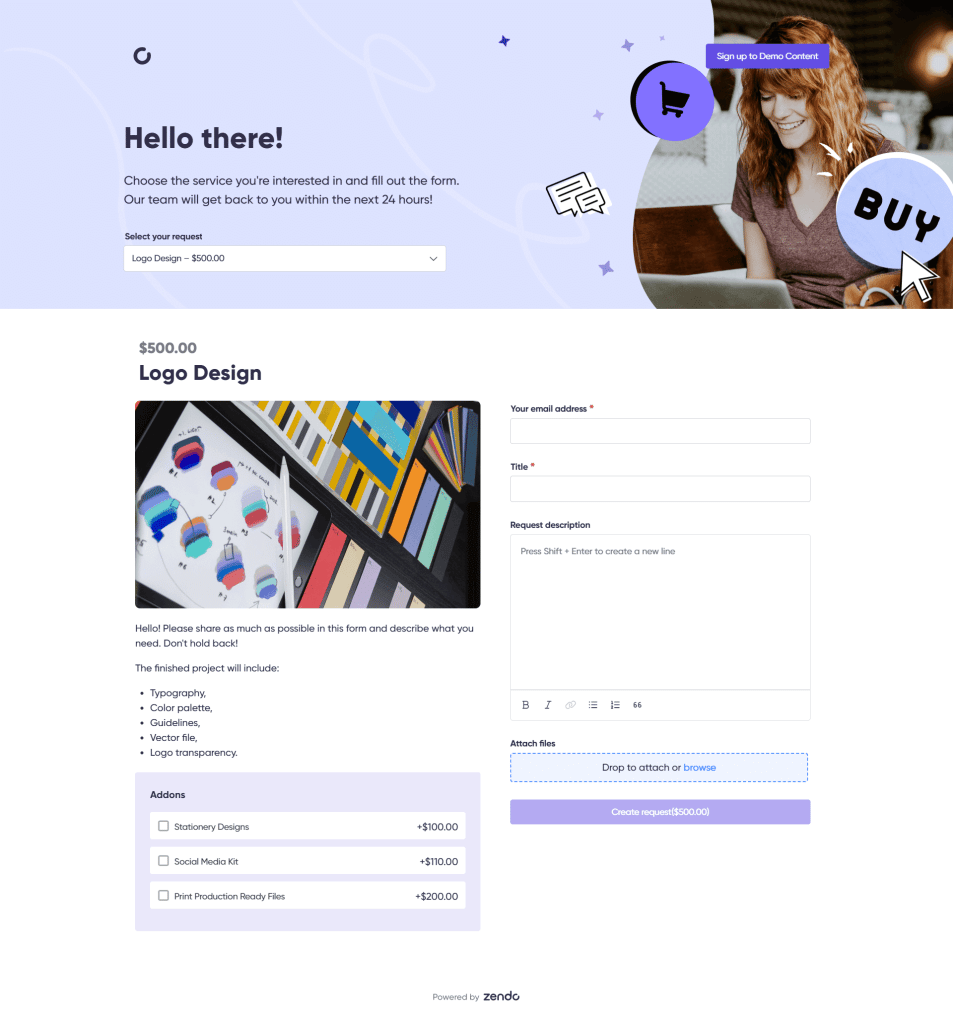Say hello to Bob.
Bob is an online entrepreneur who one day would love to have his own thriving business offering design services. It’s a dream he desperately wants to make true — but at the moment, as a lone freelancer, he’s too busy to even think about it in more detail. Between running his social media, acquiring new clients, delivering projects on a tight deadline, and sending reminders that payments are due, Bob feels overwhelmed. Who knew that offering custom services would be so tough!
Is there a way to optimize and simplify Bob’s small business, so that it’s less time-consuming yet generates more income?
There sure is! With the help of productized services, not only can you optimize your business to generate faster results, but you can also have an easier time convincing potential clients to give you a shot thanks to clear-cut terms and conditions.
Productized Services, Explained with Bob
But first, what is a productized service?
A productized service is a predefined, standardized service that comes with defined parameters and pricing upfront. It means that your potential customers know from the start what exactly they get, what additional services they can ask for, and in what timeframe.
In order to visualize that we’ll use Bob, our fledgling freelancer. At the moment, his process follows the following structure:
- He promotes and offers custom proposals in a vague way, encouraging potential customers to hop up on a video chat to discuss any projects.
- Several new clients inquire about the services through email; due to time zone differences, the communication goes slowly.
- Some clients choose the video chat option, but they forget about the meeting, so there are delays.
- Those who made it this far, agree on a proposal — but in the middle, they’re struck by new inspiration or make last-minute changes to the scope of the service.
- The custom proposal is drafted and signed by both parties; Bob can deliver his service now after confirming the advance payment went through, which might also take a while,
- The client seems happy enough about the results, but they ask for changes, revisions, or ongoing support, resulting in more back and forth,
- In the end, the client finalizes the payment after straining poor Bob’s nerves. Sadly, the payment won’t be enough to cover the therapist’s bill.
In the ideal world, selling professional services would be a breeze; everyone would have stellar communication skills, be decisive right from the beginning, and have clear expectations. Unfortunately, whoever has worked with people knows that it’s a futile dream.
So keeping that in mind, you — and Bob as well — can take a more realistic approach to crafting your business model and create a productized service instead. What would that look like, in practice?
- Logo design was the most common service customers asked Bob for. So Bob decides to create service packages focused on logos, specifically. Bob promotes it all over his website and social media.

- Now, prospective clients can look up the service and understand exactly what they’re getting and whether they can afford it. Because of the removed ambiguity, clients can decide faster if they want to work with Bob.
- Once the new client reaches out to Bob, they don’t have to negotiate as much — after all, the terms of services were already explained.
- If Bob invested in his own software for business management, he can automate the process by setting up premade forms and questionnaires to further reduce the negotiation part.
- Once all the parties agree on the terms and conditions, and the upfront payment has been finalized, Bob can start working on the logo.
- When it’s ready, clients can review the project and ask for up to three revisions, in accordance with the terms. This way, Bob eliminated the risk of clients asking for endless little edits that waste his time and money.
Thanks to the productized services model, both the client and Bob can enjoy a much better experience. After all, clients also gain major benefits from this type of business transaction.
If anyone’s in a hurry — as most clients tend to be — fast delivery time is crucial. Long negotiations and exchanging back-and-forth messages are convenient to no one. So if you offer a much smoother customer experience, not only will you gain an advantage over your competitors, but also gain a higher chance of repeating clients and being recommended.
When it comes to Bob, having a structured process will be helpful in terms of delivering quality work more consistently, as well as saving time by automating his workflow and reusing the same resources (such as templates, proposals, and contracts).
Bob Introduces Productized Consulting Services
Bob has built up a pretty sweet reputation as a reliable service provider. Currently he has many clients, but thanks to the new business model, he also has time and resources to expand his productized service offering. He came up with a new idea — a productized consulting service — that could bring more revenue for less effort. Following the productization method, Bob creates a special offer with three pricing tiers:

And that’s how Bob’s first successful productized service was created.
Bob Introduces Subscription Based Services
With time, Bob noticed that more and more customers were coming back for his exemplary services — apparently, his professionally presented offers as well as consistent, high quality work keep making an impression. This gave Bob a new idea — why not offer subscription-based services to his best paying customers, with whom he built a pleasant business relationship already? This way, he could secure a nice recurring revenue and not worry as much about acquiring new clients all the time.
Before, Bob would have been apprehensive about becoming a dedicated designer. After all, it would be easy to get exploited, fast — the expectations and responsibilities could slowly go up over time with no change in rates due to Bob’s low assertiveness.
But the productized services approach taught Bob how to dictate the terms and conditions to any collaboration. When preparing his proposal, he focuses on very specific descriptions of his work responsibilities, measurable amount of work delivered each month, and any other caveats that will ensure healthy work conditions.
Now, Bob has partnered up with a digital marketing agency owner where he helps with digital content creation. They’ve agreed on 5 illustrations per month in 3 versions adjusted for different social media. Any extra content will be considered outside of the current deal for additional price, which was discussed in advance.
Another client needs help from Bob, but the responsibilities during the monthly service tend to differ wildly, so specifying the exact scope is next to impossible. Therefore, Bob offers working on the billable hours basis, but being aware that it can quickly get out of control, he introduces some caveats in the form of three tiers.

Because of that approach, all parties know exactly what they’ve signed up for and there’s no space for exploitation, unpaid hours, or any other nasty surprises.
Bob Scales His Own Business Successfully
At a certain point, no amount of productization can save Bob from overworking, since commissions tend to pile up. He became the victim of his own success! Thankfully, it’s what Bob wanted all along — to be able to scale up and start hiring people. Now Bob is a proud business owner of a digital agency.
Agencies face certain challenges. First of all, in the case of custom services, estimating projects tends to include lots of guesswork. It’s easy to underestimate how much certain tasks will take and there’s no accounting for risks, delays, or unexpected incidents. All that leads to lost time and money.
Another way of losing money is by overdelivering. While it’s nice to offer something extra once in a while to delight clients, it’s easy to overdo it. Agreeing on more revisions, edits, or support service can make clients used to high quality work for less money, which won’t work in your favor for long. And the final payment will get pushed further and further away.
Fortunately, Bob sticks to productized services even as an agency owner. Because of the varied offers with different pricing tiers and upselling techniques, not only does customer acquisition become easier, but also the cooperation gets smoother.
Additionally, Bob decided to invest in a project management software to optimize the work of his team even further. He considered many different options — Dubsado, HoneyBook, and Plutio — but in the end, he chose Zendo. Not only does this software product support teamwork best with a helpful online chat, but productized businesses as well.

Thanks to Zendo, Bob can now create a robust form for clients to fill out before even making the first contact. Now, the first conversation between the two will go faster and more efficiently, because of the information shared. The forms can also force clients to think more deeply about what they truly want and need, while bonus addons can encourage them to spend more on you. They can also understand what’s available and what’s not, reducing the number of redundant questions and misunderstandings. What’s not to love?
Who Else Should Consider Productized Service Business?
Bob, our wonderful graphic designer, is now one of many business owners who can enjoy all the benefits that stem from similar business models. More than that, many online marketplaces — such as Fiverr or Upwork — encourage online entrepreneurs to create a productized service, knowing that this way, they can facilitate customer acquisition and convince freelancers to keep using their site as a proxy.

Moreover, more and more tools keep popping up on the market that help productized service businesses find their footing fast. Not only do they enable creating your own packages, but even help setting up prices through calculators, like Sprout Studio.
So if you care about consistent and predictable revenue as well as simplified marketing and optimization, you should give productized services a try. If you’re not sure how to go about it, you can check out our productized service examples list for some inspiration!
If your service is too custom to be productized successfully — as in the case of software companies — you can still consider implementing it partially or at least glean some tips and tricks. But in general, people working in social media management, traditional consulting, marketing services, and any creative industries, as well as online entrepreneurs, can change their online businesses for the better, saving their time and generating stable revenue for years to come.

A free online training. Delivered daily to your inbox to grow your productized agency.
What Is Zendo?
Zendo is a universal, all-in-one solution that helps freelancers and small to medium businesses sell their custom & productized services as well as subscriptions. It also doubles as a Client Portal, where your customers have their own dedicated space to keep track of their requests, view documents, talk to the team, finalize payments and submit new requests. It’s an affordable solution to business management woes that handles your administrative tasks and takes care of your internal processes.
What Is A Productized Service?
A productized service comes with a fixed scope & price, where the parties involved know upfront all the terms and conditions pertaining to the service, such as deadlines, number of revisions, etc. Its biggest benefit is that it helps sell services faster, because it cuts down on the time spent negotiating. It also paints you as an honest person who upholds transparency and cultivates trust.
What Is A Recurring Productized Service?
A recurring productized service is simply a subscription, where your clients pay for your services in a weekly, monthly, quarterly, or yearly basis, ensuring a much more stable and predictable revenue. More often than not, businesses offer a specific number of hours a month of work, or offer a concrete number of deliverables (for example, 5 articles per month or 10 social media illustrations).
Can You Create Subscriptions In Zendo?
Of course! Zendo allows you to set up subscription-based services that may consist of several packages to give your clients more choices. They can be set to different billing cycles — weekly, monthly, quarterly, or yearly — and they can have various limits, so that you’re not buried under work all the time.











